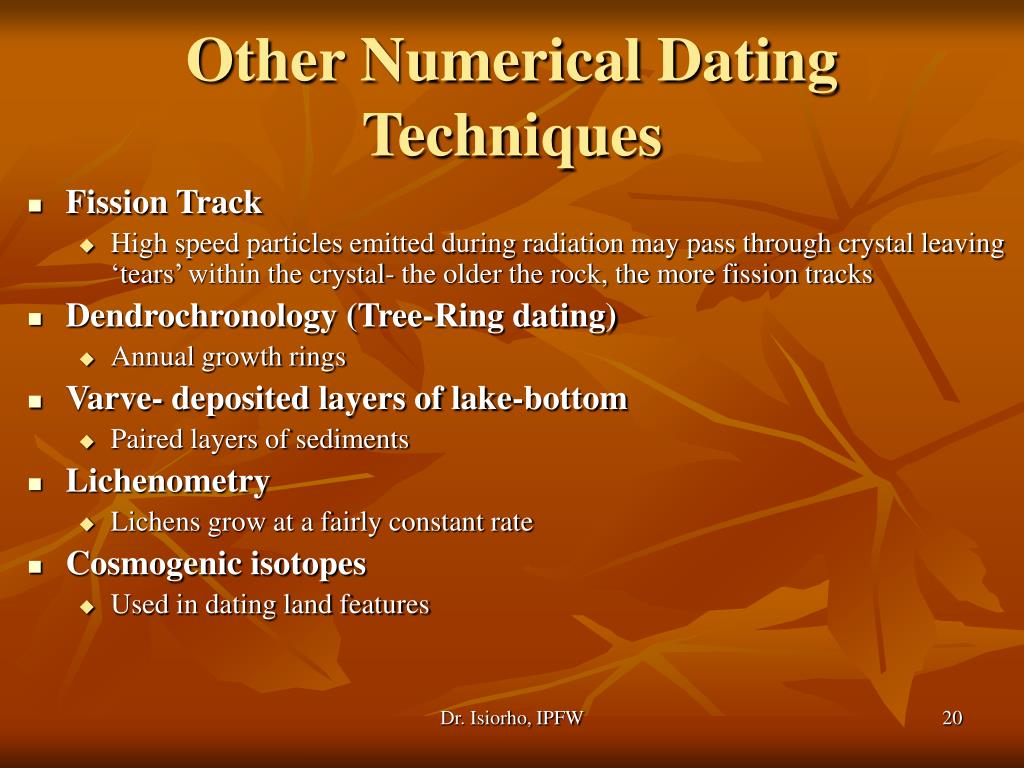Another radioisotopic relationship method involves carbon and is useful for courting archaeologically essential samples containing natural substances like wood or bone. Radiocarbon dating, additionally called carbon courting, makes use of the unstable isotope carbon-14 (14C) and the secure isotope carbon-12 (12C). Carbon-14 is consistently being created within the atmosphere by the interaction of cosmic particles with atmospheric nitrogen-14 (14N) [11]. Cosmic particles corresponding to neutrons strike the nitrogen nucleus, kicking out a proton however leaving the neutron within the nucleus. The collision reduces the atomic quantity by one, altering it from seven to six, changing the nitrogen into carbon with the identical mass variety of 14.
The uranium/lead method, with its two cross-checking clocks, is most often used with crystals of the mineral zircon (ZrSiO4) where uranium can substitute for zirconium within the crystal lattice. Zircon is proof against weathering which makes it helpful for dating geological events in ancient rocks. During metamorphic occasions, zircon crystals might type multiple crystal layers, with each layer recording the isotopic age of an event, thus tracing the progress of the several metamorphic occasions [16]. Patterson analyzed meteorite samples for uranium and lead utilizing a mass spectrometer.
Is radiometric relationship accurate?
Absolute relationship strategies tend to work higher for igneous and metamorphic rocks. These valuable strategies are critical to geologists finding out rocks and fossils. Fundamentally, they underscore the truth of ‘deep time’ by revealing clues about what Earth appeared like- lengthy earlier than the very first people appeared.
What method of rock dating is utilizing stratigraphy method?
The rate of radioactive decay is constant over time and serves as a reliable clock. Through geologic time, the polarity of the Earth’s magnetic field has switched, causing reversals in polarity. The Earth’s magnetic field is generated by electrical currents which are produced by convection within the Earth’s core. During magnetic reversals, there are in all probability modifications in convection in the Earth’s core leading to modifications within the magnetic field. The Earth’s magnetic field has reversed many instances during its historical past.
What makes radiometric dating possible?
… Sedimentary rocks by no means have particles that contain radioactive isotopes. Radiocarbon dating measures radioactive isotopes in once-living organic materials as an alternative of rock, utilizing the decay of carbon-14 to nitrogen-14. Because of the pretty fast decay rate of carbon-14, it could only be used on materials as much as about 60,000 years previous. Geologists use radiocarbon so far such materials as wooden and pollen trapped in sediment, which signifies the date of the sediment itself. We will consider three of them here—alpha decay, beta decay, and electron capture. Alpha decay is when an alpha particle, which consists of two protons and two neutrons, is emitted from the nucleus of an atom.
Based on Hutton’s precept of uniformitarianism (see Chapter 1), early geologists surmised geological processes work slowly and the Earth is very outdated. Relative courting ideas was how scientists interpreted Earth history till the top of the 19th Century. Because  science advances as technology advances, the discovery of radioactivity within the late 1800s provided scientists with a model new scientific tool called radioisotopic dating. Using this new know-how, they might assign specific time units, in this case years, to mineral grains within a rock.
science advances as technology advances, the discovery of radioactivity within the late 1800s provided scientists with a model new scientific tool called radioisotopic dating. Using this new know-how, they might assign specific time units, in this case years, to mineral grains within a rock.
How does radiometric dating aid in determining the ages of rocks?
Radiometric courting uses thermal ionization mass spectrometers to measure the isotopic ratios. Index fossils are normally fossil organisms which may be widespread, simply identified, and found across a large space. Fossil traces have been present in rocks of all ages, with the simplest organisms found within the oldest rocks. These methods are correct just for material starting from a few thousand to 500,000 years old — some researchers argue the accuracy diminishes considerably after a hundred,000 years.
